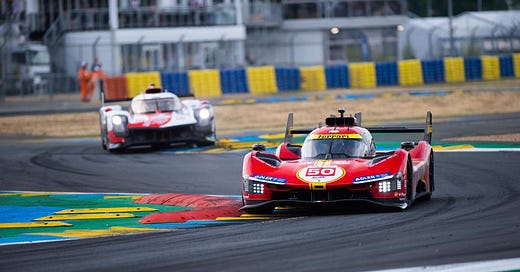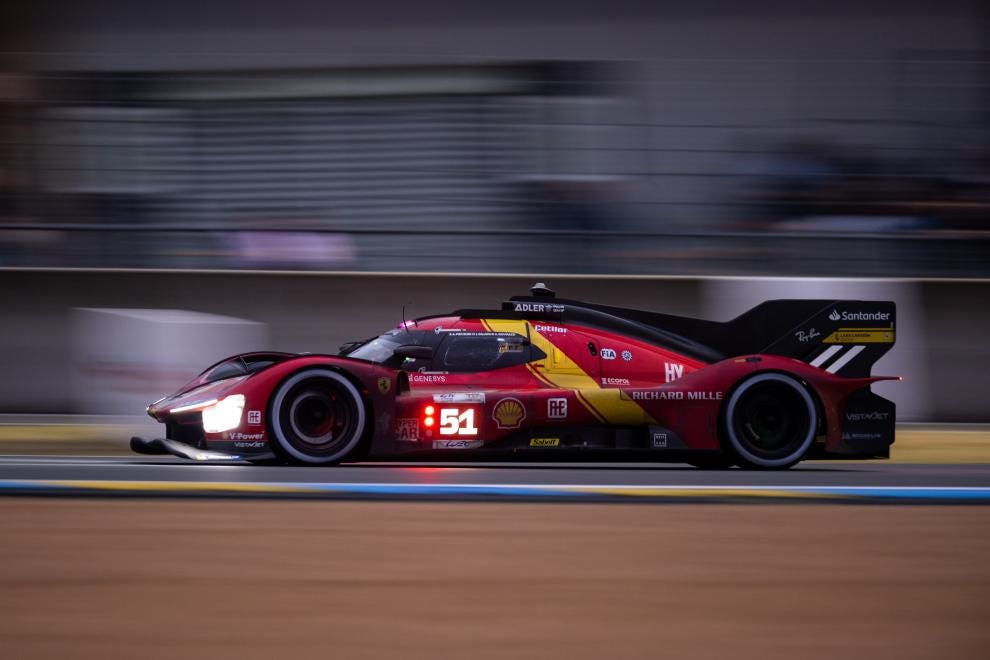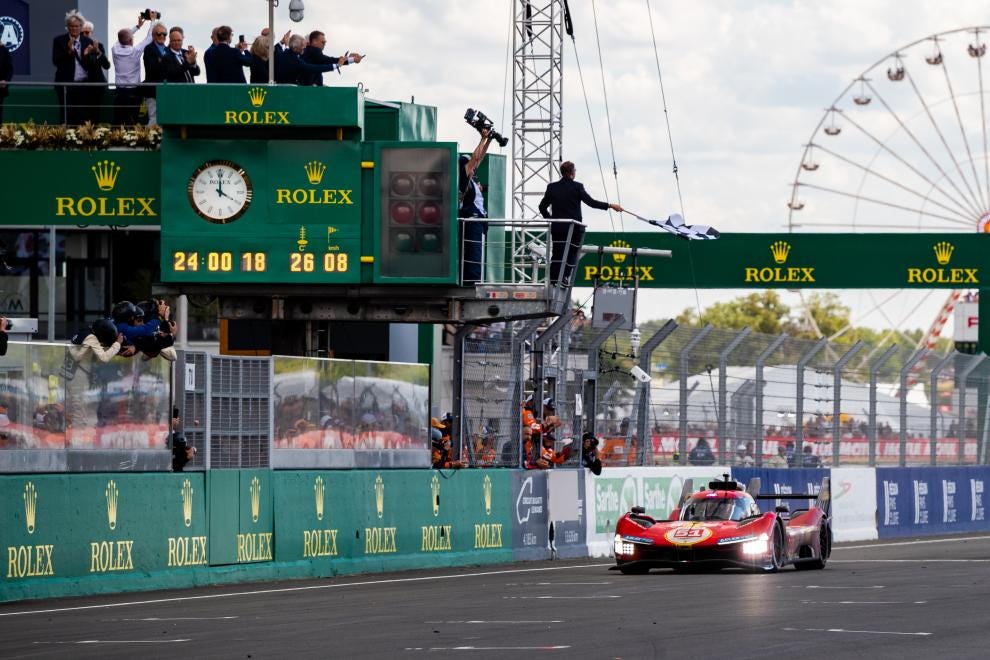Clashes of the Titans
The competitive Hypercar battle at Le Mans capped by Ferrari's stunning win suggests the next golden era of top-level sports car racing is in full swing.
Sports-car endurance races aren't decided in the first hour, let alone on the first lap. Every once in a while, however, their tone can be set early--even at the first corner.
Seconds after the 62-car field crossed the start-finish line to begin the 2023 24 Hours of Le Mans, Sébastien Buemi maneuvered his No. 8 Toyota Hypercar to the inside Felipe Nasr's No. 75 Porsche. As they approached the sharp left-turn entrance to the Dunlop chicane, the Porsche fought back, crossing behind the Toyota in a bid to seize the inside line. The move was a bit too ambitious, and Nasr briefly locked up his brakes, sending the Porsche car into the side of the Toyota.
Everybody remained pointed in the right direction, but the message was clear. Defending champion Toyota was in for a fight, and not just for first place. This dust-up was for third, behind a pair of Team AF Corse Ferraris.
The opening 12 seconds of 91st 24 Hours of Le Mans served as a sign that this edition would play out very differently from recent ones, at least for the top-class Hypercars.
The formidable, two-car Toyota Gazoo factory team rolled into Le Mans having won the last five races--four of them 1-2 finishes. But 2023 brought something new: more competition.
Specifically, an opportunity for world sports car racing's top-class cars to compete in both the World Endurance Championship (WEC), which counts Le Mans among its events, and the U.S.-based IMSA WeatherTech SportsCar Championship.
The new top-class rules, which also seek to lower development costs, mean that car makers can race one design in two major global series. In the WEC, they are Hypercars; in IMSA, Grand Touring Prototypes, or GTPs.
The appeal was enough to pull in several big names, including Cadillac, Ferrari, Porsche, and Peugeot--each of which had multiple cars at Le Mans and are competing for either the full-season WEC Hypercar title, the IMSA GTP title, or both.
IMSA's GTP class gained an instant competitive boost as Porsche and BMW (which did not enter a top-class car at Le Mans, but plans to in 2024) joined holdovers Acura and Cadillac. The European-based newcomers, each with two cars, logged a win and six podiums between them in the first four IMSA races.
A similar battle in WEC wasn't expected right away, especially at Le Mans--a nod to Toyota's recent dominance. The Japanese juggernaut came to Le Mans having won not only the last five events there, but also all three WEC races in 2023.
Still, there were signs the newcomers were ready to mount a serious challenge. Ferrari's lone entry at Sebring in March was fastest qualifier and finished third. At Portimão in April, both Ferrari and Porsche put one of their two entries on the podium.
Fast-forward to Le Mans race week, and Ferrari made its biggest statement yet, putting its No. 50 and No. 51 499Ps on the front row. But qualifying pace and race pace are two different things, as is surviving a 24-hour race duration compared to a short qualifying stint.
Toyota knows this as well as anyone. In 2016, the team was three minutes away from its first overall Le Mans victory when the No. 5 just stopped on the main straightaway, practically in front of the team's pit box. A defect on a simple part--a connector line between the turbocharger and intercooler--handed victory to Porsche.
That win was Porsche's second in a row, coming on the heels of five straight Audi wins dating back to 2010. Porsche won again in 2017 and promptly dropped its top-class sports car program. That opened the door for Toyota, by then the lone remaining factory-backed top-tier team, to go on its dominant, five-year run.
Teams with that level of bona fides don't back down, and Toyota certainly did not this past weekend at Le Mans. By the end of the first lap, Buemi was back in front, suggesting a 24-hour fistfight was underway.
The only factor that cooled the fight was on-track troubles. Rain and accidents--many of the latter caused by the former--meant more than half of the race's first three hours and large chunks of the first 12 hours were run with a safety car or some portion of the 8.5-mile Circuit de la Sarthe under a mandatory slow-down, do-not-pass edict.
Given the opportunity to race, the big-money Hypercar teams did not hold back.
The first 10 hours included 23 lead changes among nine cars representing five manufacturers--Toyota, Porsche, Cadillac, Ferrari, and Peugeot--noted Alex Harrison of WEC Data (a must-follow on Twitter at @WECData.)
Le Mans-style adversity challenged every one of the top contenders. All three factory-backed Penske Porsches suffered mechanical problems, while the lone customer-entry Porsche, fielded by Team Jota, crashed out.
Both factory Peugeots had technical and on-track problems.
One Cadillac crashed on the opening lap, while a second was rear-ended entering a slow zone by a LMGTE AM-class car that didn't heed the yellow flags. The third, the No. 2 Chip Ganassi Cadillac Racing entry, was nearly flawless on track but needed frequent oil top-ups, extending its pit-stop times and costing it a shot at the win. It would end up third--the brand's first Le Mans podium.
Toyota and Ferrari were not immune. Near the end of the eighth hour, the No. 51 Ferrari pitted from the lead. On his out lap and speeding towards the Mulsanne Straight's Daytona Chicane, Alessandro Pier Guidi came upon two cars in trouble. Trying to avoid the same fate, he instead spun into the gravel trap. In what would prove to be a pivotal moment in the race, the track-side marshals got the crane hooked up in no time, sending the Ferrari on its way.
Five minutes later, Toyota's chances suffered their first serious blow. Running in second place, Kamui Kobayashi in the No. 7 eased into Tertre Rouge, which was designated as a slow zone for a previous incident. But two drivers behind him apparently missed the prompts, slamming into the back of the Toyota and knocking it out of the race.
Ferrari absorbed the next blow. Late in the 10th hour, the No. 50--as in 50 years since Ferrari's last top-class Le Mans appearance--needed an extended stint in the garage to fix a radiator leak. It returned, but its hopes of an overall win were all but gone.
That left center stage to the No. 51 Ferrari and No. 8 Toyota. They did not disappoint, swapping the lead multiple times as night turned to day ahead of the scheduled 16:00 Le Mans time finish. With four hours to go, the pair was 3 seconds apart.
Early in the 23rd hour, Ferrari would get the breathing room it needed. Brendon Hartley ran a quadruple stint, putting the No. 8 Toyota within 15 sec. of the No. 51 Ferrari. Just before pitting to hand the car over to teammate Ryo Hirakawa for the finish, Hartley repeated an often-noted reminder over the team radio: Brake too hard on used tires and the rear wheels will lock up.
The team elected not to change tires, and out Hirakawa went, determined to run the Ferrari down. Instead, he locked the rear wheels heading into Arnage and spun. The miscue put the No. 8 more than three minutes behind the No. 51.
But the drama wasn't done. With 24 minutes to go, Pier Guidi--tapped to wrap up Ferrari's first overall Le Mans win in 58 years--came to pit road for one last, fuel-only stop.
Once the crew was done, however, the Ferrari did not move.
Per WEC series rules, engines are shut off during pit stops. When Pier Guidi went to re-start his car, it showed a warning light, which the team knew was bogus. A similar issue during an Hour 20 pit stop had prepared them--getting around the warning required the Hypercar equivalent of a computer reboot. So Pier Guidi--with nothing more than a historic victory hanging in the balance--calmly went through the process.
After 40 seconds, the Ferrari was back out--its lead over the Toyota cut to under one minute.
A bit more than 20 minutes later, the No. 51 led the field under the checked flag. Pier Guidi and co-drivers James Calado and Antonio Giovinazzi ended Toyota's dominance and completed a remarkable 11-month run from the 499P’s first on-track shakedown to first place in the world’s most prestigious motor race.
Is 2023 the first win in a run for Ferrari--only the fourth make to claim a Le Mans overall victory since 2009?
Perhaps. But don’t bet on it.
More probable is that the Italian team emphatically ushered in a memorable era of top-tier sports car battles between a handful of big-money, factory-backed teams a few quality, independent "privateers" mixed in. (Glickenhaus, the U.S.-based sports car company working with a fraction of the big teams’ budgets, placed its two entries sixth and seventh at Le Mans, ahead of eight big-name teams and another privateer, Floyd Vanwall Racing.)
One ironclad guarantee: tickets to the next WEC race, on July 9, will not be easy to get. It takes place in Monza, Italy--about a two-hour drive from Maranello, Ferrari’s home.
References
WEC Data on lead changes— https://twitter.com/WECDATA/status/1667672886855753728
Toyota No. 8 brake balance—https://www.dailysportscar.com/2023/06/11/2023-lm24-hour-23-toyota-falls-at-the-penultimate-hurdle.html
Ferrari's final pit stop—https://sportscar365.com/lemans/wec/elkann-le-mans-win-produces-unforgettable-day-for-ferrari/
Ferrari’s first shakedown—https://sportscar365.com/lemans/wec/ferrari-completes-positive-first-rollout-of-lmh-car-at-fiorano/







